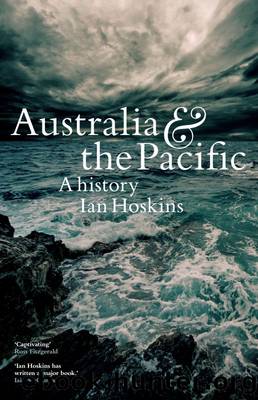Australia & the Pacific by Ian Hoskins

Author:Ian Hoskins
Language: eng
Format: epub
Publisher: NewSouth Publishing
Published: 2021-09-08T00:00:00+00:00
âa substantial abrogation of Australian sovereigntyâ
What were the values Australians were defending? Japan and Germany had been allied since the Tripartite Pact of 1940. Both countries agreed to respect the establishment of âa new orderâ in each otherâs spheres, Europe and East Asia. Those new orders were totalitarian, antidemocratic and violently repressive. Nazi Germany was genocidally racist. Against them were ranged not only the Allied military forces but also a collective of 26 countries, including Australia, called the âUnited Nationsâ â a precursor of sorts to the United Nations (UN), formally established in October 1945. Their Declaration, signed in early 1942, made a commitment to defend âlife, liberty, independence and religious freedom ⦠human rights and justiceâ.52 This was the philosophical basis of Australiaâs war. That UN values ran through Australian society, notwithstanding the deep vein of racism and exploitative self-interest also to be found there, is evidenced by the belief of the aforementioned un-named soldier in Changi in âthe simple recognition of the importance of another human beingâs experienceâ.53
John Curtin made mention of the âUnited Nationsâ in an exultant letter to General MacArthur when the latter arrived in Australia on 17 March 1942 to take command of the American forces already assembled there to take the fight to the Japanese. âThis is a momentous occasion for the peoples of the United Nationsâ, the prime minister wrote, â ⦠You have come to Australia to lead a crusade the result of which means everything to the future of the world and mankindâ. And he continued, âAt the request of a sovereign nation you are being placed in Supreme Command of its Navy, Army and Air Force â¦â54 That referred to the process which would see MacArthur become the Supreme Commander of the Allied forces in Australia and the near Pacific. From 18 April, MacArthur had formal command of some 370 000 Australian combat troops. His theatre of command was subsequently called the South West Pacific Area (SWPA) to distinguish it from the South Pacific Area which included Norfolk Island and New Zealand. Delighted though Curtin was with MacArthurâs appointment, the US did not consult Curtin about the demarcation and neither was he pleased with it. The Americans held sway, as did MacArthur.
That was the reality of Curtinâs âlookâ to America to which Paul Keating referred approvingly in 1992. His speech was intended both to shift the focus of Anzac Day from Gallipoli to New Guinea and make a claim for the mantle of a sovereign foreign policy for the Labor Party. The address was delivered amidst that renewed interest in Australiaâs New Guinea and Papuan campaign which prompted the memoirs of Ted Fulton and Tod Schacht. There was considerable academic review at this time too. One unifying theme was a critical reassessment of the AustralianâUS relationship and the role of the divisive figure of General MacArthur, whose counsel Curtin generally accepted over his Australian officers. The conclusions often sat awkwardly with Keatingâs nationalist and polemical revisionism. Lex McAulayâs popular history
Download
This site does not store any files on its server. We only index and link to content provided by other sites. Please contact the content providers to delete copyright contents if any and email us, we'll remove relevant links or contents immediately.
| Africa | Americas |
| Arctic & Antarctica | Asia |
| Australia & Oceania | Europe |
| Middle East | Russia |
| United States | World |
| Ancient Civilizations | Military |
| Historical Study & Educational Resources |
Machine Learning at Scale with H2O by Gregory Keys | David Whiting(4179)
Never by Ken Follett(3790)
Fairy Tale by Stephen King(3220)
The Man Who Died Twice by Richard Osman(2997)
Oathbringer (The Stormlight Archive, Book 3) by Brandon Sanderson(2877)
Will by Will Smith(2792)
Rationality by Steven Pinker(2291)
The Dark Hours by Michael Connelly(2243)
Can't Hurt Me: Master Your Mind and Defy the Odds - Clean Edition by David Goggins(2226)
The Dawn of Everything: A New History of Humanity by David Graeber & David Wengrow(2122)
Friends, Lovers, and the Big Terrible Thing by Matthew Perry(2119)
Principles for Dealing With the Changing World Order: Why Nations Succeed and Fail by Ray Dalio(1974)
HBR's 10 Must Reads 2022 by Harvard Business Review(1776)
A Short History of War by Jeremy Black(1762)
Go Tell the Bees That I Am Gone by Diana Gabaldon(1687)
515945210 by Unknown(1599)
A Game of Thrones (The Illustrated Edition) by George R. R. Martin(1588)
Kingdom of Ash by Maas Sarah J(1524)
443319537 by Unknown(1470)
